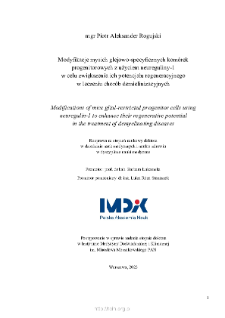
Object
Title: Modifications of mice glial-restricted progenitor cells using neuregulin-1 to enhance thier regenerative potential in the treatment of demyelinating diseases.
Contributor:
Łukomska, Barbara (Promotor) ; Stanaszek, Luiza Róża (Promotor pomocniczy)
Publisher:
Instytut Medycyny Doświadczalnej i Klinicznej im.M. Mossakowskiego PAN
Place of publishing:
Degree name:
Level of degree:
Degree discipline :
Abstract:
I aimed to investigate the influence of neuregulin-1 (NRG-1) on the functional properties of glial-restricted progenitor cells (GRPs). The hypothesis I sought to verify was that overexpressing neuregulin-1 in GRPs would alter their functional characteristics, potentially enhancing their application potential in the therapy of demyelination-related diseases. The study focused on GRPs isolated from mouse fetal nervous tissue (referred to as mGRPs). To induce overexpression of neuregulin-1 type I (NRG-1 type I), genetic modifications were performed on mGRPs through the transduction of cells using lentiviral vectors encoding NRG-1 type I. The research involved analyzing the expression levels of NRG-1 in the modified mGRPs, examining their phenotype, and investigating the functional properties of mGRPs-NRG-1 in vitro. Evaluation of mGRPs transduced with the pLenti-GIII-CMV-NRG-1 type I-mCherry vector demonstrated that these cells exhibit varying levels of NRG-1 type I transcript synthesis in subsequent transduction attempts, and their continued culture leads to spontaneous detachment of cells from the surface of the culture vessel and subsequent cell death. The unfavorable results obtained from transducing mGRPs with the pLenti-GIII-CMV-NRG-1 type I-mCherry vector prompted me to use the HIV-SFFV-NRG-1 type I-IRES-mRFP vector for the next phase of the study. This vector encodes NRG-1 type I sequence and the mRFP fluorescent reporter protein, separated by the IRES (Internal Ribosome Entry Site) sequence. This arrangement allows for the coexpression of both sequences under the transcriptional control of a shared promoter, while their translation occurs independently. In the next stage of the study, I attempted to transduce mGRPs with lentiviral activating particles designed to overexpress the endogenous NRG-1 gene (NRG-1-LAPs). However, simultaneous transduction of mGRPs with the three lentiviral vectors comprising the NRG-1-LAPs system proved ineffective. Therefore, the attempt to induce endogenous NRG-1 overexpression in mGRPs through transduction with lentiviral activating particles was unsuccessful. In light of the setbacks associated with genetic modifications aimed at overexpressing NRG-1 in mGRPs, I decided to conduct additional research based on the stimulation of mGRPs with exogenous recombinant mouse neuregulin-1 peptide (rmNRG-1) through its supplementation in the standard culture medium. Supplementation of mGRPs with rmNRG-1 peptide had a diverse impact on the phenotype of the cells in vitro. Based on the conducted research, the following conclusions can be drawn: - overexpression of NRG-1 type I, achieved by transducing mGRPs with lentiviral vectors, resulted in a decrease in the growth rate of these cells and promoted their differentiation towards oligodendrocytes; however, I did not observe a significant impact of NRG-1 type I overexpression on the myelination properties of mGRPs - my preliminary investigations into the stimulation of mGRPs using exogenous recombinant neuregulin-1 peptide indicate an enhanced proliferation rate and reduced migratory capacity of supplemented mGRPs, accompanied by a diminished capability of these cells to differentiate into mature oligodendrocytes - the findings presented in my doctoral thesis highlight that the influence of neuregulin-1 on the functional properties of mGRPs is contingent upon the experimental setup.
Detailed Resource Type:
Format:
Resource Identifier:
Source:
Language:
Language of abstract:
Rights:
Creative Commons Attribution BY 4.0 license
Terms of use:
Copyright-protected material. [CC BY 4.0] May be used within the scope specified in Creative Commons Attribution BY 4.0 license, full text available at: ; -
Digitizing institution:
Mossakowski Medical Research Institute PAS
Original in:
Library of the Mossakowski Medical Research Institute PAS
Projects co-financed by:
Access:
Object collections:
- Digital Repository of Scientific Institutes > Partners' collections > Mossakowski Medical Research Institute PAS
- Digital Repository of Scientific Institutes > Partners' collections > Mossakowski Medical Research Institute PAS > Theses > Ph.D Dissertationes
- Digital Repository of Scientific Institutes > Literature > Thesis
Last modified:
Dec 14, 2023
In our library since:
Dec 14, 2023
Number of object content downloads / hits:
125
All available object's versions:
https://www.rcin.org.pl/publication/276356
Show description in RDF format:
Show description in RDFa format:
Show description in OAI-PMH format:
Objects Similar
Jurga, Marcin
Habich, Aleksandra
Bużańska, Leonora
Drela, Katarzyna

 INSTYTUT ARCHEOLOGII I ETNOLOGII POLSKIEJ AKADEMII NAUK
INSTYTUT ARCHEOLOGII I ETNOLOGII POLSKIEJ AKADEMII NAUK
 INSTYTUT BADAŃ LITERACKICH POLSKIEJ AKADEMII NAUK
INSTYTUT BADAŃ LITERACKICH POLSKIEJ AKADEMII NAUK
 INSTYTUT BADAWCZY LEŚNICTWA
INSTYTUT BADAWCZY LEŚNICTWA
 INSTYTUT BIOLOGII DOŚWIADCZALNEJ IM. MARCELEGO NENCKIEGO POLSKIEJ AKADEMII NAUK
INSTYTUT BIOLOGII DOŚWIADCZALNEJ IM. MARCELEGO NENCKIEGO POLSKIEJ AKADEMII NAUK
 INSTYTUT BIOLOGII SSAKÓW POLSKIEJ AKADEMII NAUK
INSTYTUT BIOLOGII SSAKÓW POLSKIEJ AKADEMII NAUK
 INSTYTUT CHEMII FIZYCZNEJ PAN
INSTYTUT CHEMII FIZYCZNEJ PAN
 INSTYTUT CHEMII ORGANICZNEJ PAN
INSTYTUT CHEMII ORGANICZNEJ PAN
 INSTYTUT FILOZOFII I SOCJOLOGII PAN
INSTYTUT FILOZOFII I SOCJOLOGII PAN
 INSTYTUT GEOGRAFII I PRZESTRZENNEGO ZAGOSPODAROWANIA PAN
INSTYTUT GEOGRAFII I PRZESTRZENNEGO ZAGOSPODAROWANIA PAN
 INSTYTUT HISTORII im. TADEUSZA MANTEUFFLA POLSKIEJ AKADEMII NAUK
INSTYTUT HISTORII im. TADEUSZA MANTEUFFLA POLSKIEJ AKADEMII NAUK
 INSTYTUT JĘZYKA POLSKIEGO POLSKIEJ AKADEMII NAUK
INSTYTUT JĘZYKA POLSKIEGO POLSKIEJ AKADEMII NAUK
 INSTYTUT MATEMATYCZNY PAN
INSTYTUT MATEMATYCZNY PAN
 INSTYTUT MEDYCYNY DOŚWIADCZALNEJ I KLINICZNEJ IM.MIROSŁAWA MOSSAKOWSKIEGO POLSKIEJ AKADEMII NAUK
INSTYTUT MEDYCYNY DOŚWIADCZALNEJ I KLINICZNEJ IM.MIROSŁAWA MOSSAKOWSKIEGO POLSKIEJ AKADEMII NAUK
 INSTYTUT PODSTAWOWYCH PROBLEMÓW TECHNIKI PAN
INSTYTUT PODSTAWOWYCH PROBLEMÓW TECHNIKI PAN
 INSTYTUT SLAWISTYKI PAN
INSTYTUT SLAWISTYKI PAN
 SIEĆ BADAWCZA ŁUKASIEWICZ - INSTYTUT TECHNOLOGII MATERIAŁÓW ELEKTRONICZNYCH
SIEĆ BADAWCZA ŁUKASIEWICZ - INSTYTUT TECHNOLOGII MATERIAŁÓW ELEKTRONICZNYCH
 MUZEUM I INSTYTUT ZOOLOGII POLSKIEJ AKADEMII NAUK
MUZEUM I INSTYTUT ZOOLOGII POLSKIEJ AKADEMII NAUK
 INSTYTUT BADAŃ SYSTEMOWYCH PAN
INSTYTUT BADAŃ SYSTEMOWYCH PAN
 INSTYTUT BOTANIKI IM. WŁADYSŁAWA SZAFERA POLSKIEJ AKADEMII NAUK
INSTYTUT BOTANIKI IM. WŁADYSŁAWA SZAFERA POLSKIEJ AKADEMII NAUK


































